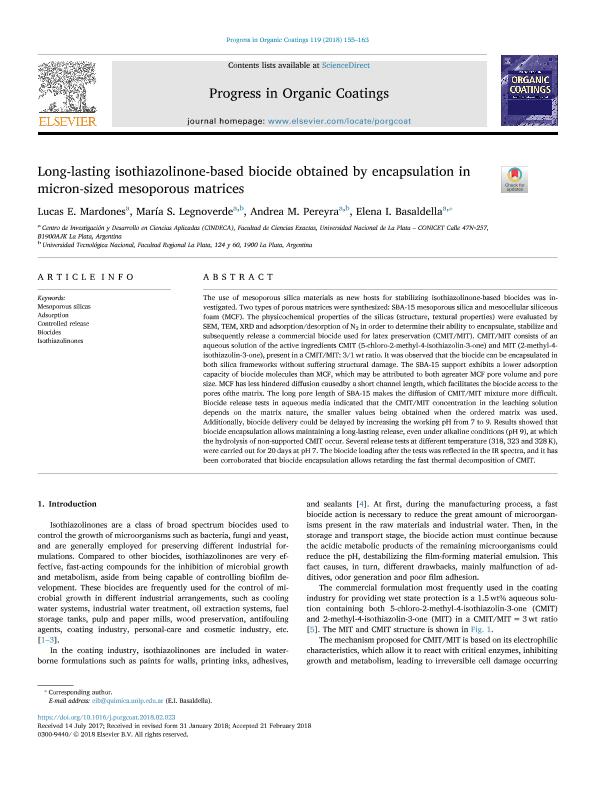Mostrar el registro sencillo del ítem
dc.contributor.author
Mardones, Lucas Emanuel

dc.contributor.author
Legnoverde, María Soledad

dc.contributor.author
Pereyra, Andrea Marisa

dc.contributor.author
Basaldella, Elena Isabel

dc.date.available
2019-10-09T20:49:37Z
dc.date.issued
2018-06
dc.identifier.citation
Mardones, Lucas Emanuel; Legnoverde, María Soledad; Pereyra, Andrea Marisa; Basaldella, Elena Isabel; Long-lasting isothiazolinone-based biocide obtained by encapsulation in micron-sized mesoporous matrices; Elsevier; Progress in Organic Coatings; 119; 6-2018; 155-163
dc.identifier.issn
0300-9440
dc.identifier.uri
http://hdl.handle.net/11336/85478
dc.description.abstract
The use of mesoporous silica materials as new hosts for stabilizing isothiazolinone-based biocides was investigated. Two types of porous matrices were synthesized: SBA-15 mesoporous silica and mesocellular siliceous foam (MCF). The physicochemical properties of the silicas (structure, textural properties) were evaluated by SEM, TEM, XRD and adsorption/desorption of N2 in order to determine their ability to encapsulate, stabilize and subsequently release a commercial biocide used for latex preservation (CMIT/MIT). CMIT/MIT consists of an aqueous solution of the active ingredients CMIT (5-chloro-2-methyl-4-isothiazolin-3-one) and MIT (2-methyl-4-isothiazolin-3-one), present in a CMIT/MIT: 3/1 wt ratio. It was observed that the biocide can be encapsulated in both silica frameworks without suffering structural damage. The SBA-15 support exhibits a lower adsorption capacity of biocide molecules than MCF, which may be attributed to both agreater MCF pore volume and pore size. MCF has less hindered diffusion causedby a short channel length, which facilitates the biocide access to the pores ofthe matrix. The long pore length of SBA-15 makes the diffusion of CMIT/MIT mixture more difficult. Biocide release tests in aqueous media indicated that the CMIT/MIT concentration in the leaching solution depends on the matrix nature, the smaller values being obtained when the ordered matrix was used. Additionally, biocide delivery could be delayed by increasing the working pH from 7 to 9. Results showed that biocide encapsulation allows maintaining a long-lasting release, even under alkaline conditions (pH 9), at which the hydrolysis of non-supported CMIT occur. Several release tests at different temperature (318, 323 and 328 K), were carried out for 20 days at pH 7. The biocide loading after the tests was reflected in the IR spectra, and it has been corroborated that biocide encapsulation allows retarding the fast thermal decomposition of CMIT.
dc.format
application/pdf
dc.language.iso
eng
dc.publisher
Elsevier

dc.rights
info:eu-repo/semantics/openAccess
dc.rights.uri
https://creativecommons.org/licenses/by-nc-nd/2.5/ar/
dc.subject
ADSORPTION
dc.subject
BIOCIDES
dc.subject
CONTROLLED RELEASE
dc.subject
ISOTHIAZOLINONES
dc.subject
MESOPOROUS SILICAS
dc.subject.classification
Ingeniería de los Materiales

dc.subject.classification
Ingeniería de los Materiales

dc.subject.classification
INGENIERÍAS Y TECNOLOGÍAS

dc.title
Long-lasting isothiazolinone-based biocide obtained by encapsulation in micron-sized mesoporous matrices
dc.type
info:eu-repo/semantics/article
dc.type
info:ar-repo/semantics/artículo
dc.type
info:eu-repo/semantics/publishedVersion
dc.date.updated
2019-10-04T13:09:05Z
dc.journal.volume
119
dc.journal.pagination
155-163
dc.journal.pais
Países Bajos

dc.journal.ciudad
Amsterdam
dc.description.fil
Fil: Mardones, Lucas Emanuel. Consejo Nacional de Investigaciones Científicas y Técnicas. Centro Científico Tecnológico Conicet - La Plata. Centro de Investigación y Desarrollo en Ciencias Aplicadas "Dr. Jorge J. Ronco". Universidad Nacional de la Plata. Facultad de Ciencias Exactas. Centro de Investigación y Desarrollo en Ciencias Aplicadas; Argentina
dc.description.fil
Fil: Legnoverde, María Soledad. Consejo Nacional de Investigaciones Científicas y Técnicas. Centro Científico Tecnológico Conicet - La Plata. Centro de Investigación y Desarrollo en Ciencias Aplicadas "Dr. Jorge J. Ronco". Universidad Nacional de la Plata. Facultad de Ciencias Exactas. Centro de Investigación y Desarrollo en Ciencias Aplicadas; Argentina. Universidad Tecnológica Nacional; Argentina
dc.description.fil
Fil: Pereyra, Andrea Marisa. Consejo Nacional de Investigaciones Científicas y Técnicas. Centro Científico Tecnológico Conicet - La Plata. Centro de Investigación y Desarrollo en Ciencias Aplicadas "Dr. Jorge J. Ronco". Universidad Nacional de la Plata. Facultad de Ciencias Exactas. Centro de Investigación y Desarrollo en Ciencias Aplicadas; Argentina. Universidad Tecnológica Nacional; Argentina
dc.description.fil
Fil: Basaldella, Elena Isabel. Consejo Nacional de Investigaciones Científicas y Técnicas. Centro Científico Tecnológico Conicet - La Plata. Centro de Investigación y Desarrollo en Ciencias Aplicadas "Dr. Jorge J. Ronco". Universidad Nacional de la Plata. Facultad de Ciencias Exactas. Centro de Investigación y Desarrollo en Ciencias Aplicadas; Argentina
dc.journal.title
Progress in Organic Coatings

dc.relation.alternativeid
info:eu-repo/semantics/altIdentifier/doi/http://dx.doi.org/10.1016/j.porgcoat.2018.02.023
dc.relation.alternativeid
info:eu-repo/semantics/altIdentifier/url/https://www.sciencedirect.com/science/article/pii/S0300944017306781
Archivos asociados
